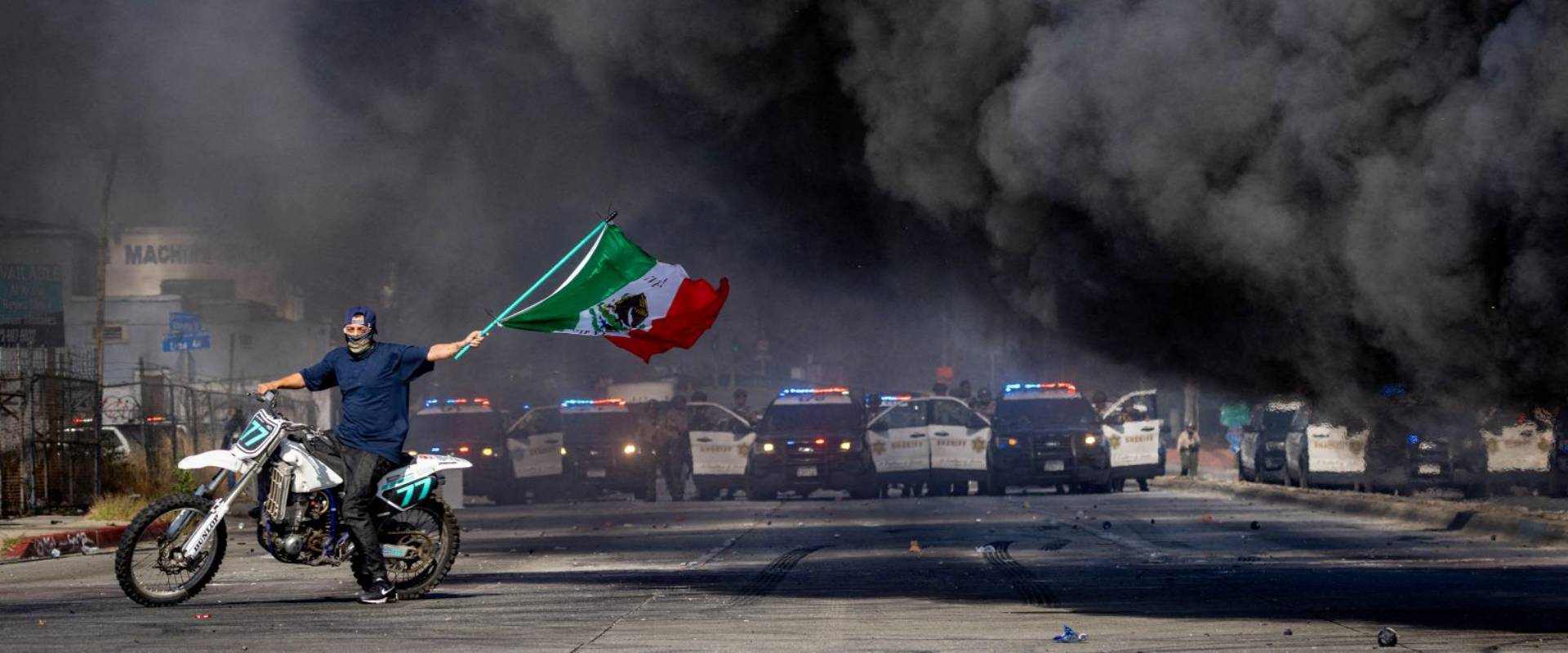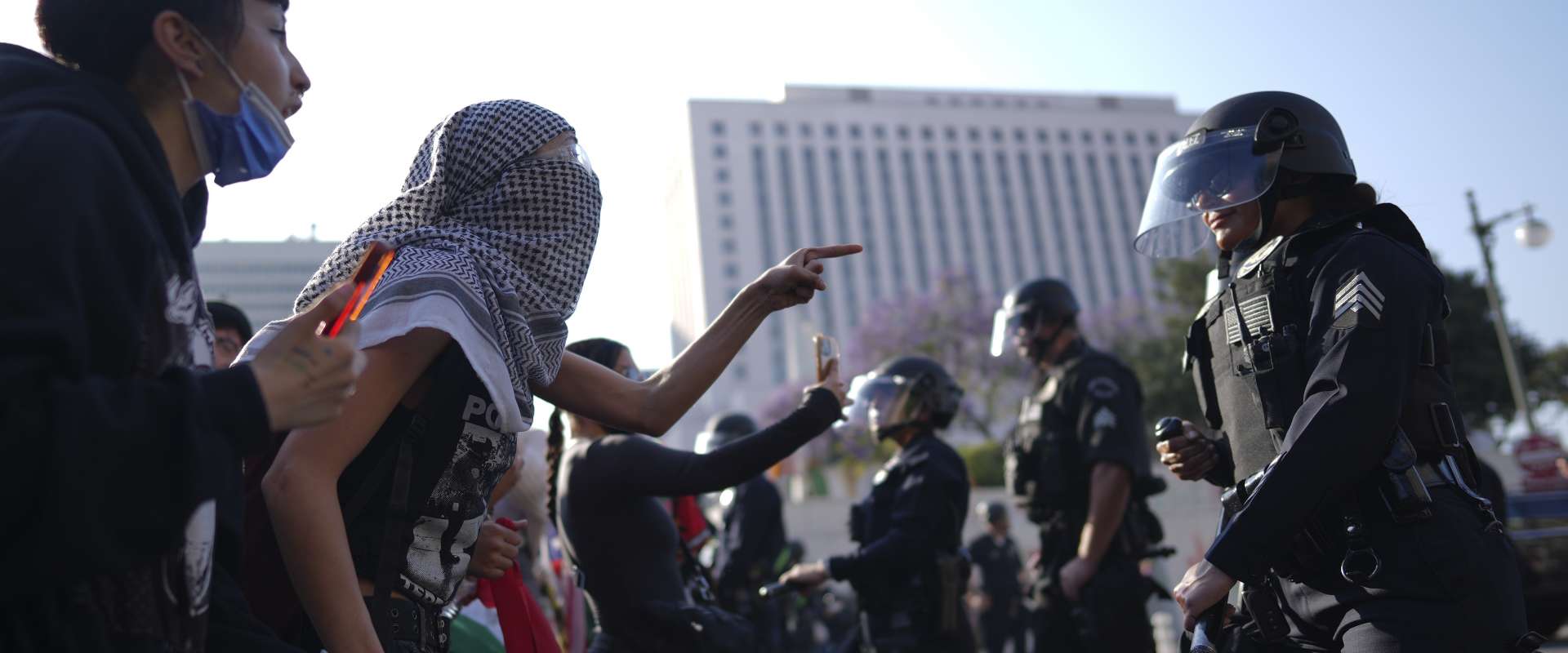A revolt contained, but polarization continues
In 2020, we witnessed the biggest wave of protests in the United States in the past 50 years, if not ever. The George Floyd rebellion was the highest phase so far in a long series of cycles in the recent Black liberation movement, extending from Oscar Grant’s murder in 2009, through the upsurge of Black Lives Matter in 2013–2015, and all the way to that fiery summer of 2020.. What has happened since then?
Over the past three years, the state has successfully repressed and co-opted the wave of multiracial Black liberation struggle. It has repressed the movement through militarized violence and secret police infiltration. It has also co-opted Black Lives Matter through surface-level reforms, Democratic Party election campaigns, and liberal political figures. This co-optation was helped along by certain middle-class leaders who sought wealth and a certain notoriety from grifting from the movement.
Yet that spirit of resistance did not entirely subside. Bolstered by a tight labor market post-COVID, working-class people turned to workplace struggles and unionization campaigns — notably but not exclusively at Starbucks and Amazon. The rising confidence of labor found reflection in Striketober, an “anti-work” internet culture, and now the Hollywood strikes. But, however exciting they are, without institutions and a strategy to generalize and expand these struggles and connect them beyond sectional issues, they remain limited..
Another major trend during and after 2020 was mutual aid. Activists moved from street protest and confronting power into “charity from below” — crowd-sourced fundraising appeals, “feed the people” ventures, and community kitchens, and so on. COVID was an initial catalyst, with these efforts at first driven by the state’s refusal to address people’s needs during the pandemic. However, the trend expanded in the wake of the political setbacks of the 2020 rebellions and deliberate interventions from figures like Alexandra Ocasio-Cortez.
The far right is also growing more and more confident. Like the Black liberation struggle, it too has gone through cycles of development. It is an ideology that reinforces capitalism and thus has an easier time resourcing its movement. But additionally, the absence of a serious independent left has allowed the right to benefit from major events to grow politically and organizationally.
COVID was perhaps the greatest boon to the far right in recent years. The far right capitalized on the left’s failure to politicize the pandemic, and it directed middle-class and alienated workers’ anger into conspiracy theories like QAnon. During the 2020 election, far-right movements were able to organize much wider layers of individual Trump supporters behind their banners than they did in 2016. This rising tide culminated in the January 6 assault on the Capitol building.
After indictments and state crackdowns that temporarily put the far right on its heels, the fascists have regrouped. Attacks on reproductive rights and LGBTQ+ people (especially trans people) are the leading edge of the right’s campaign for growth post-January 6. Re\pressive bills in state legislatures, lone-wolf vigilantes, and fascist assaults on drag story hours all build upon one another. These different forms of attack are connected, even if they might not be coordinated.
All of this reflects continued, deepening polarization. While the ruling class has contained the Black liberation revolt (for a time), broad sections of the youth and the working class remain quite radical. Though the far right represents a serious danger to our lives, society remains in a state of contestation — not outright reaction as was the case during the Reagan years.
Coming economic crisis and imperial conflict
We can expect the recent banking crisis to expand into a full-blown economic crisis. While it appears that central banks stepped in and contained the runs on Silicon Valley Bank, Credit Suisse, and others, this is only temporary. Even bourgeois economists have predicted a mild recession in the next six months. We now face two possibilities: downturn or continued inflation — and if the latter isn’t contained, potentially both combined.
What if it’s a downturn? Central banks, in attempting to contain rising prices, are hiking interest rates to cool off the economy and associated wage demands. They erroneously believe both that wages are to blame for inflation, and that hiking interest rates has a major effect on inflation. In reality, supply-chain disruptions, productivity, and price-gouging issues related to COVID and the Ukraine war are the real culprits of the rising prices.
Hiking rates may not address inflation, but it will kick off a downturn similar to the Volker shock of the early 1980s. This will not entirely be the responsibility of central banks, however.
In bailing out the financial system the last time around, the central banks took on bad debt by printing more money via “quantitative easing” (QE). Through QE, the US Federal Reserve pumped roughly $4 trillion into Wall Street from 2008 to 2014. This was followed by an even greater $6 trillion worth of QE during the pandemic. These injections officially ended in March 2022.
Prior to last March, this QE allowed for rampant speculation, risky investments, and extended lives for unprofitable companies. The boom in tech ventures and Initial Public Offerings (IPOs) fed into and drew upon the rise of cryptocurrency, both of which are now facing bear markets after QE has ended. “Zombie firms,” those whose regular revenues barely cover interest payments on their debt, have been able to shamble on for years thanks to cheap credit and stock buybacks.
In the downturn, workers will face hard times. We could likely see, at least temporarily, a slowdown in private-sector workplace struggles, as workers face job insecurity and high unemployment. This, in part, is the intention behind the interest-rate shock. Meanwhile, public-sector workers may face state austerity policies aimed to pay for whatever corporate bailouts arise.
What if the inflation spiral continues? Not addressing inflation would mean continued immiseration for the working class as prices rise. This can lead to a twin inflation-and-stagnation spiral known as “stagflation.” However, continued inflation and a tight labor market could lead to even more labor struggles as workers fight for their wages to keep up with price hikes.
The violent birth of a new global order
Continued economic misery has profound implications for not only nation-based class struggles, but for the global struggle of nation-states as well.
The war in Ukraine reflects a new world situation — away from the US-dominated neoliberal order of the 1990s and 2000s. For the first time since 1991, a major world power has conducted total war on an existing nation-state, and importantly, without the tacit support of Washington. We are now witnessing the violent reshaping of the global order as the US empire’s relative decline comes face-to-face with the rise of a new superpower in China and more assertive regional imperialisms like Russia’s.
The US remains the greatest purveyor of violence in the world. As US-based revolutionaries, our main enemy is the US state and we oppose all forms of intervention and military rearmament. We fundamentally disagree with those who argue for US arms to aid Ukraine. This aid not only welds Ukraine to US and NATO as a vassal, but is driving the US to expand production in its arms industry. In turn, political support for US arms welds US workers ideologically to US imperialism.
However, though the “main enemy is at home,” that does not mean it is the only enemy. Despite some who claim that the rise of China and Russia amid a new multipolar order will usher in an era of peace, the real result will be war and violence. China’s quest for raw materials has led to a “new” scramble for Africa — one that is already entering its 10th year. With backing from the UN, China has deployed “peacekeepers” in places like South Sudan to protect their mines and fossil fuel investments. In Colombia, Chinese companies are working with local military police to protect their gold mines.
Economic and military competition between great powers is driving proxy conflicts and scrambles for spheres of influence on the path to direct war. As ever, and as Ukraine makes clear, the redivision of the world can only occur through extreme violence by imperial powers and their proxies.
In any organization that seeks world revolution and workers’ power, communists cannot entertain those who would cheer on one or another imperialism — be they old Western supremacists under the guise of “humanitarian intervention” or rising upstarts under the cloak of “anti-West peace and progress.”
A truly international working-class movement must link up with all its constituent parts in various countries — West and East, North and South — to overthrow every form of imperialism and class despotism. We settle for lesser evilism neither in elections nor in nation-states.
Instability and revolution
The continued scramble for resources by world powers echoes in the actions of lesser powers through extractivist mega projects. From Mexico to Peru and beyond, less powerful capitalist states have turned to resource extraction to enrich elites, “catch up” to global powers, and drive foreign investment. With big and small capital alike questing for profits, environmental destruction, the theft of Indigenous lands, and climate devastation continue unabated.
However, the resulting superstorms, mass refugee crises, state military violence, and economic despair also contain the seeds of revolt. Already we have seen waves of revolution and rebellion take place in Sudan, Belarus, Kazakhstan, Iran, Peru, Colombia and elsewhere in recent years. Likewise, the coming imperial conflicts will result in the mass arming of working-class people among the contesting powers. As was the case in in World War I and Vietnam, worker-soldiers could very well turn that imperialist war into a civil war, turning their guns around to face their real enemies.
The coming economic crisis, the heating up of global dangers, and the hope of revolt all put a serious urgency on developing a revolutionary movement in the US. Firebrand aims to play a vital role in that process. But what is the Left we have to work with?
To be continued in Part Two



